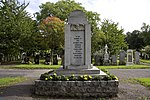Paisley Abercorn railway station
1866 establishments in Scotland1967 disestablishments in ScotlandBuildings and structures in Paisley, RenfrewshireDisused railway stations in RenfrewshireFormer Glasgow and South Western Railway stations ... and 6 more
Pages with no open date in Infobox stationRailway stations in Great Britain closed in 1967Railway stations in Great Britain opened in 1866Scotland railway station stubsTransport in Paisley, RenfrewshireUse British English from December 2016

Paisley Abercorn railway station was a railway station in Paisley, Renfrewshire, Scotland. The station was built by the Glasgow and South Western railway when the former Scotch gauge Paisley and Renfrew Railway was converted to Standard Gauge and was joined to the Glasgow and Paisley Joint Railway at Arkleston Junction.
Excerpt from the Wikipedia article Paisley Abercorn railway station (License: CC BY-SA 3.0, Authors, Images).Paisley Abercorn railway station
Renfrew Road,
Geographical coordinates (GPS) Address Website Nearby Places Show on map
Geographical coordinates (GPS)
| Latitude | Longitude |
|---|---|
| N 55.8519 ° | E -4.419 ° |
Address
West College Scotland - Paisley Campus
Renfrew Road
PA3 4DR , Williamsburgh
Scotland, United Kingdom
Open on Google Maps







